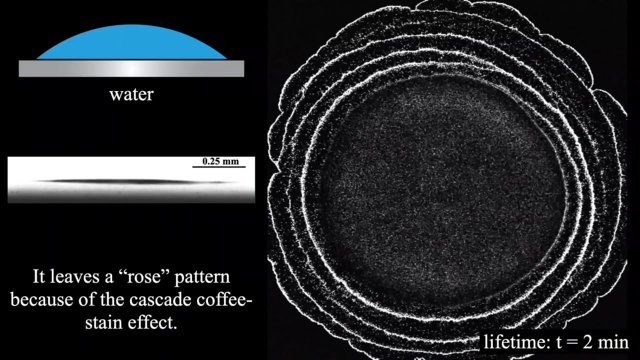The ‘coffee-stain’ effect is a well-known effect in physics and daily life: a dark-coloured edge remains when a fluid, containing particles, evaporates. This is caused by an ‘avalanche’ of particles moving to the outer edge, UT scientists showed in an earlier publication. In inkjet and 3D printing, this is an undesired effect. The effect can be suppressed by modifying the surface using an oily layer, researchers now show in the Proceedings of the National Academy of Sciences of the USA (PNAS).
Earlier work of the UT research group shows that if a particle-laden droplet evaporates, the particles start moving to the edge of the droplet. At first, this is a slow and regular movement, but as soon as the droplet loses height by evaporation, the particles rush to the edge disorderly, like in an avalanche. After full evaporation of the liquid, a dark ring remains. In fact, the diameter of the droplet already dictates this processs very early. How can we prevent this, is the question, because in many cases a homogeneous distribution is required and not a ring-shaped dark area. An oil-wetted surface is the answer, the new results show.
From homogeneous distribution to ‘coffee-eye’
In this case as well, the droplet has an edge, but this is limited by a layer of oil that does not evaporate. It also prevents the water at the droplet’s edge from evaporating fast. This, in turn, prevents particles from all moving to the edge. They even move the other way: from the edge inside the droplet. Once all water is evaporated, the particles are all over the surface and not just in a ring. The researcher also saw another effect, when the oily layer entirely covers the droptlet. In that case, a concentration of particles is formed, a so-callend nano-eye or ‘coffee eye’. This could even be a desired effect as well, in some applications, like in nanoparticle assembly. Through adding some surfactant to the droplet, the final particle deposition can be manipulated, from the concentrated ‘coffee-eye’ to a homogeneous distribution.
Disease transfer
The Physics of Fluids group has a long-term research relationship with printer manufacturer Océ, now called Canon Production Printing. This company already adds a special layer to the substrate (like paper) before the droplets of the printer drop on it: the new research results are very valuable for improving the processes. For other application areas, the new insights and improved control are valuable too, like 3D printing and surface patterning. Better insights in the way liquids evaporate on a surface, may also provide more knowledge about the way liquids with a virus like corona in them, behave on surfaces. This is one of the new research directions.
The research was done in the Physics of Fluids group and the Max Planck Center for Complex Fluid Dynamics. A week before publication, the main author of the paper, Yaxing Li (Anhui, 1991) successfully defended his PhD thesis ‘Evaporating multicomponent droplets.’
The paper ‘Evaporating droplet on oil-wetted surfaces: suppression of the coffee-stain effect’, by Yaxing Li, Christian Diddens, Tim Segers, Herman Wijshoff, Michel Versluis and Detlef Lohse, appears in the Proceedings of the National Academy of Sciences of the USA (PNAS).






